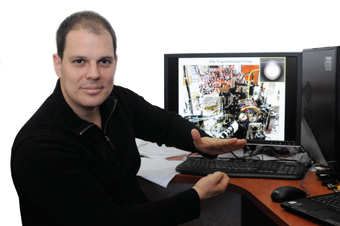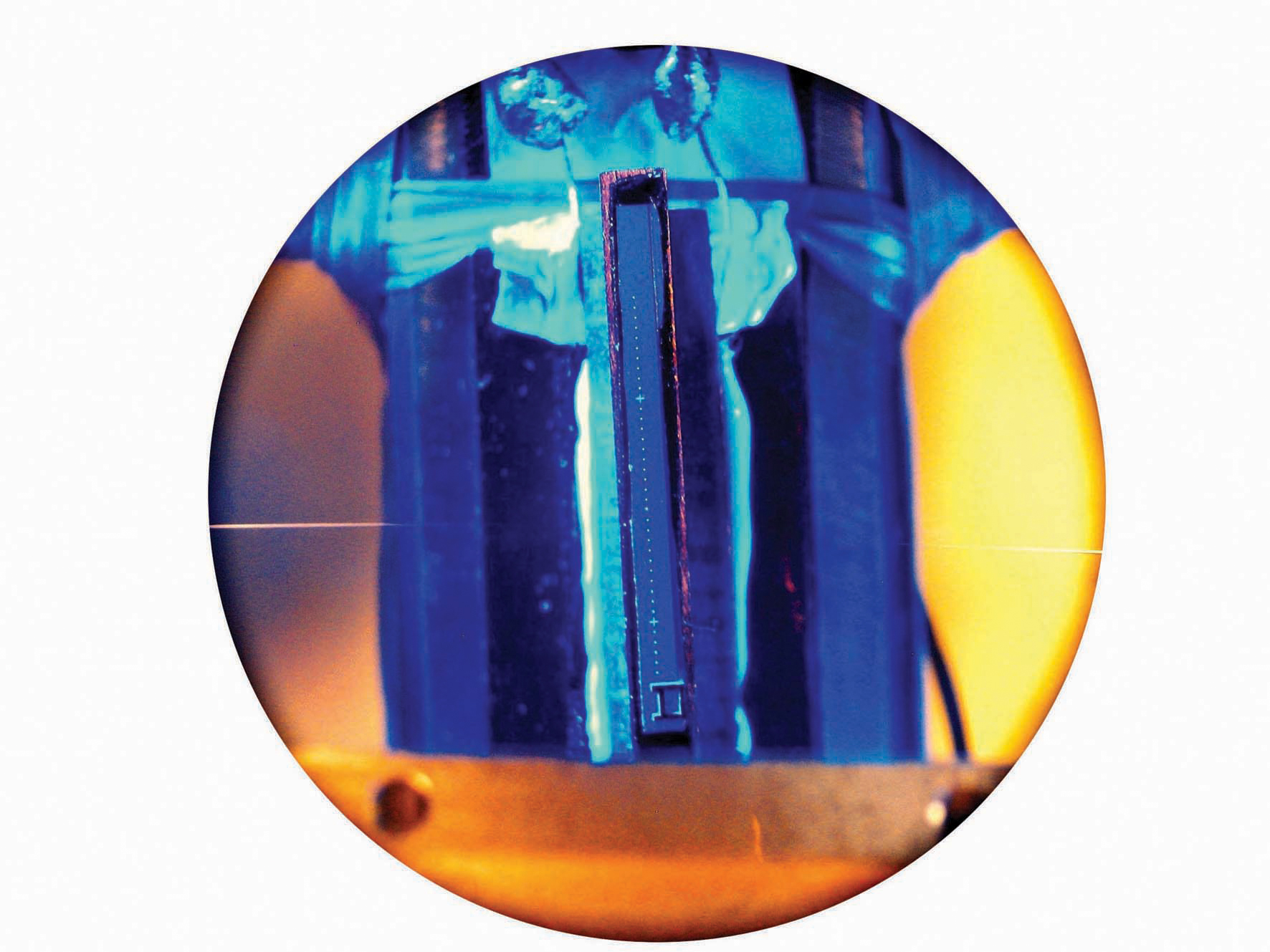Dr. Dayan is not satisfied with the ability to launch a photon that will hit the atom in a certain and consistent manner. He also wants to control the possible results of the encounter: the deflection of the photon from its path, the absorption of the photon by the atom, excitation of the atom, etc.

God does not play dice with the world"
- This is how Albert Einstein responded to the principle of randomness that is at the foundation of quantum theory. This principle allows for immediate and complete coordination between random events that occur at the same time, even at a great distance from each other - like, for example, two game dice thrown light years apart and always falling on the same numbers. Intuitively (at least that's how Einstein felt), this phenomenon is impossible. However, in practice, random systems that operate in full coordination have been observed in recent years in several laboratories around the world, and were called "intertwined systems".
The magic and "lack of logic" of the intertwined systems attracted the attention of Dr. Barak Dayan, who recently joined the department of chemical physics at the Weizmann Institute of Science. These systems are the basis of quantum optics, which may help advance the construction of powerful quantum computers. The interlaced systems offer the possibility of simultaneous calculation - that is, the testing of several solutions at the same time, through a calculation carried out according to new mathematical laws, which do not exist outside of interlaced systems. Such a parallel calculation could, for example, enable deciphering the ciphers used today, which are based on the product of very large prime numbers (performing this task using the computers that exist today is impractical because it would take a time that far exceeds the duration of a human life). Such a quantum computation is similar to the problem of scanning a large number of suitcases in search of a bomb. In normal mode, the luggage must be scanned one by one, a process that may take too long. On the other hand, treating the suitcases as interwoven systems makes it possible to check only a small part of them, and still get information on all of them - thus quickly and with certainty determine where the bomb is buried. The main limitation on the use of entangled systems for fast calculations is the well-known rule of quantum theory, according to which the measurement - or the observation - affects the result. Because of this, during the entire calculation process it is forbidden to "peek" into the system. From a practical point of view, the meaning of the matter is that the system must be isolated, and that any emission of information (light, particles, etc.) outside the system must be prevented, and the electrical or other interactions between its parts must be completely controlled. Such conditions are possible today only in very small and simple systems, consisting of atoms and single photons. "The idea is that the atom is the 'computer', and the photon transfers quantum information to and from it - that is, it functions as input and output. The minimalistic nature of the system prevents unwanted leakage of information," says Dr. Dayan. In order to build such systems and use them, and to deeply understand the relationship between atoms and photons, one must achieve full control of the mutual relationships between them - that is, to bring together a single atom with a single photon. This is a difficult task: a photon is a very weak particle, and to notice it you need a large detector (or a particularly sensitive eye, like the eyes of owls or cats). If that's not enough, the atom, to which the photon must be launched, is an extremely tiny target. Dr. Dayan is not satisfied with the ability to launch a photon that will hit the atom in a certain and consistent manner. He also wants to control the possible results of the encounter: the deflection of the photon from its path, the absorption of the photon by the atom, excitation of the atom, and the like. For this purpose, he uses unique and innovative technologies, the development of which he himself participated in in recent years: laser beams and magnetic fields control the position of individual atoms, bringing them into prolonged contact with the photons trapped in tiny resonators, as published in the scientific journal Nature. These resonators, which were developed at the California Institute of Technology (Caltech), consist of beads similar to optical fibers, and their diameter does not exceed 30 microns (a third of the thickness of a human hair). Inside these rings the photons move. Another direction investigated in Dr. Dayan's laboratory is encounters and interactions between photons, mediated by an atom. This is an even more complex challenge, since photons do not tend to "talk" to each other. In his post-doctoral research, Dr. Dayan created a "revolving door" for photons in a resonator. The photons may arrive at the resonator as individuals or in pairs or triplets, but always leave it singly, one by one.
This work, which was published in the scientific journal Science, is one of the few examples that exist to this day of interactions between photons. Understanding these interrelationships may help develop ways to optimize the transfer of information in communication systems. "Today's communication world is based on the transfer of information through light, in optical fibers," says Dr. Dayan, "However, today there is a need for advanced electronic equipment that regulates traffic (for example, to allow information coming from elsewhere to join the path of existing information). By creating a switching based on optics, the photons moving in the optical fiber will be able to signal to the joining photons 'Wait a minute, we are passing'". Interrelationships between photons could also serve as a basis for developing logic gates for quantum computing. "My ambition is that we will be able to control photons the way we know how to control electrons today. Such an ability will make it possible to move the field of communication and computing from today's classical world to the quantum world, with all the possibilities inherent in that."

personal
Barak Dayan was born in Tel Aviv in 1970, and served in the IDF as part of the "Talfiot" program.
In 1992 he completed his undergraduate studies in physics and mathematics, and in 1999 he received his master's degree in physics - both from the Hebrew University in Jerusalem. After serving in the defense system, he continued to study for a PhD in physics in the laboratory of Prof. Yaron Zilberberg in the Department of Physics of Complex Systems at the Weizmann Institute of Science.
In this framework, he participated in the establishment of a new laboratory in the field of quantum optics. One of his experiments in his doctoral thesis provided one of the first demonstrations of interactions between pairs of entangled photons, showing that in the entangled state they are governed by different mathematical laws than those that describe normal systems. After post-doctoral research in a quantum optics laboratory, under the guidance of Prof. Jeff Kimball from the California Institute of Technology (Caltech), Dayan returned to Israel, and in 2008 joined the faculty of the chemical physics department as a senior researcher. During his studies at the institute, he participated in the preparation and guidance of courses for teenagers. He directs his interest in science education mainly towards his children, Tamar, eight years old, and Oded, three years old, and he likes to spend most of his free time in their company.

6 תגובות
Does it cost money to write here?
By God I understood everything until you decided to weave.
What Hebrew isn't a hard word anyway?
A little pity for old immigrants who try to read from right to left (or from top to bottom...after the interweaving the directions have no meaning...)
Measurement is a slightly different phenomenon from interactions with elementary particles. Measurement is a system (true, still consisting of interactions with elementary particles, but many of them) that links and increases the microscopic (quantum) world to the macroscopic world. Inherently, macroscopicity leads to a decrease (of many orders of magnitude) in the level of entanglement.
Interactions of elementary particles also lead to a decrease in the level of entanglement given enough time/space. To maintain interweaving, you have to build all kinds of exotic systems, with a temperature close to absolute zero, etc.
The action of interaction between elementary particles is a constant phenomenon. There is nothing special that distinguishes the measurement operation. So it's hard for me to see how it explains anything.
point:
Yes, of course. Time and measurement make an intertwined system unentangled. The degree of entanglement is a quantitative phenomenon, although it is not usually treated as such. In a physical system, naturally, the degree of entanglement between two particles decreases exponentially in time and space.
What prevents us from saying that the entire universe is in an interwoven state from the moment of the big bang. What makes things stop being intertwined? time? measurement? These do not seem to me to be sufficient to change the fundamental state of particles.
That is, it is possible that the cube God plays with is a cube that obeys the laws he has set.